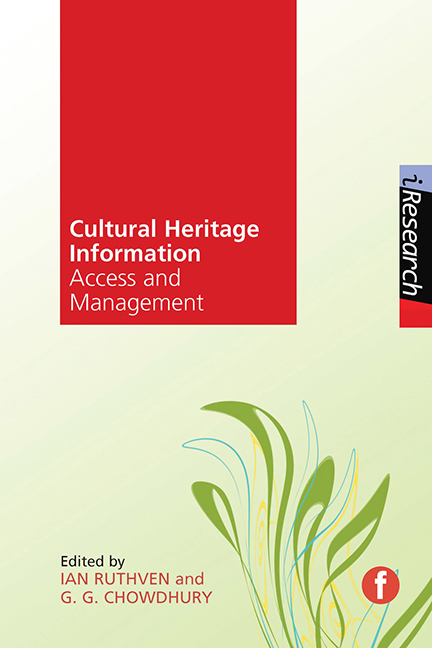Book contents
- Frontmatter
- Contents
- List of figures and tables
- Contributors
- Preface
- 1 Managing digital cultural heritage information
- 2 Digital humanities and digital cultural heritage (alt-history and future directions)
- 3 Management of cultural heritage information: policies and practices
- 4 Cultural heritage information: artefacts and digitization technologies
- 5 Metadata in cultural contexts – from manga to digital archives in a linked open data environment
- 6 Managing cultural heritage: information systems architecture
- 7 Cultural heritage information: users and usability
- 8 A framework for classifying and comparing interactions in culturalheritage information systems
- 9 Semantic access and exploration in cultural heritage digital libraries
- 10 Supporting exploration and use of digital cultural heritage materials: the PATHS perspective
- 11 Cultural heritage information services: sustainability issues
- Index
8 - A framework for classifying and comparing interactions in culturalheritage information systems
Published online by Cambridge University Press: 10 September 2022
- Frontmatter
- Contents
- List of figures and tables
- Contributors
- Preface
- 1 Managing digital cultural heritage information
- 2 Digital humanities and digital cultural heritage (alt-history and future directions)
- 3 Management of cultural heritage information: policies and practices
- 4 Cultural heritage information: artefacts and digitization technologies
- 5 Metadata in cultural contexts – from manga to digital archives in a linked open data environment
- 6 Managing cultural heritage: information systems architecture
- 7 Cultural heritage information: users and usability
- 8 A framework for classifying and comparing interactions in culturalheritage information systems
- 9 Semantic access and exploration in cultural heritage digital libraries
- 10 Supporting exploration and use of digital cultural heritage materials: the PATHS perspective
- 11 Cultural heritage information services: sustainability issues
- Index
Summary
Introduction
For centuries, cultural heritage institutions have acted as guardians of the society's cultural memory, guiding visitors and researchers through historic and contemporary assets while explaining their significance and value. Through digitization of cultural heritage and online access to it, memory institutions such as museums, libraries and archives have the opportunity to unlock the potential of their material. Recent technological developments enable organizations to reach a broad spectrum of people with different backgrounds and to facilitate contextualization of cultural heritage artefacts in an unprecedented way, thus opening up new horizons in experiencing cultural heritage.
Most institutions seized the opportunity to revive their hidden heritage by digitizing objects and publishing and displaying a digital surrogate on a website or information system. They seek meaningful presentations of their digitized cultural heritage data with regard to display of context and purposeful interactions, but transferring context and significance of objects in a digital environment is not a trivial task. In most cases, the digital representations do not reflect the context the original artefacts were embedded in. This leads to a loss of meaningful, and often expensively curated, information and the question of what purposeful interactions with digital cultural heritage should entail.
Cultural heritage information systems need to be differentiated from systems accessing pure textual content. The main differences between a generic information system and one storing and accessing cultural heritage are the potential interactions with the digital content. First, the information system needs to offer appropriate access functionalities that bring meaningful objects to the surface and ensure important information does not get buried in a pile of low-quality metadata. Second, they need to enable the users to immerse themselves in the historic situation an object gained significance from and make clear in which context it was created. In the best case, context and digital objects are so interweaved that they transport the user back in time, simulating the historic setting. Presenting and showcasing cultural heritage and striving for enthusing users about their heritage through the means of the digital medium should be the goal of memory institutions.
One might consider these to be dreams of the future, because a lot of steps need to be taken for this vision to become a reality.
- Type
- Chapter
- Information
- Cultural Heritage InformationAccess and Management, pp. 153 - 176Publisher: FacetPrint publication year: 2015
- 2
- Cited by



